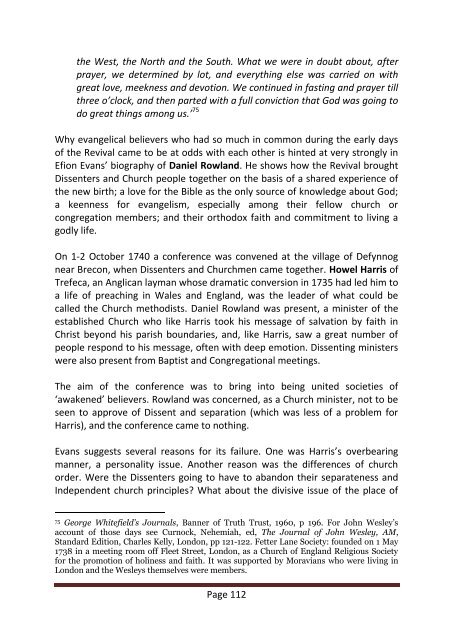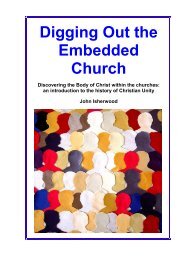Christian Unity (the book) - The Maranatha Community
Christian Unity (the book) - The Maranatha Community
Christian Unity (the book) - The Maranatha Community
You also want an ePaper? Increase the reach of your titles
YUMPU automatically turns print PDFs into web optimized ePapers that Google loves.
<strong>the</strong> West, <strong>the</strong> North and <strong>the</strong> South. What we were in doubt about, afterprayer, we determined by lot, and everything else was carried on withgreat love, meekness and devotion. We continued in fasting and prayer tillthree o’clock, and <strong>the</strong>n parted with a full conviction that God was going todo great things among us.’ 75Why evangelical believers who had so much in common during <strong>the</strong> early daysof <strong>the</strong> Revival came to be at odds with each o<strong>the</strong>r is hinted at very strongly inEfion Evans’ biography of Daniel Rowland. He shows how <strong>the</strong> Revival broughtDissenters and Church people toge<strong>the</strong>r on <strong>the</strong> basis of a shared experience of<strong>the</strong> new birth; a love for <strong>the</strong> Bible as <strong>the</strong> only source of knowledge about God;a keenness for evangelism, especially among <strong>the</strong>ir fellow church orcongregation members; and <strong>the</strong>ir orthodox faith and commitment to living agodly life.On 1-2 October 1740 a conference was convened at <strong>the</strong> village of Defynnognear Brecon, when Dissenters and Churchmen came toge<strong>the</strong>r. Howel Harris ofTrefeca, an Anglican layman whose dramatic conversion in 1735 had led him toa life of preaching in Wales and England, was <strong>the</strong> leader of what could becalled <strong>the</strong> Church methodists. Daniel Rowland was present, a minister of <strong>the</strong>established Church who like Harris took his message of salvation by faith inChrist beyond his parish boundaries, and, like Harris, saw a great number ofpeople respond to his message, often with deep emotion. Dissenting ministerswere also present from Baptist and Congregational meetings.<strong>The</strong> aim of <strong>the</strong> conference was to bring into being united societies of‘awakened’ believers. Rowland was concerned, as a Church minister, not to beseen to approve of Dissent and separation (which was less of a problem forHarris), and <strong>the</strong> conference came to nothing.Evans suggests several reasons for its failure. One was Harris’s overbearingmanner, a personality issue. Ano<strong>the</strong>r reason was <strong>the</strong> differences of churchorder. Were <strong>the</strong> Dissenters going to have to abandon <strong>the</strong>ir separateness andIndependent church principles? What about <strong>the</strong> divisive issue of <strong>the</strong> place of75George Whitefield’s Journals, Banner of Truth Trust, 1960, p 196. For John Wesley’saccount of those days see Curnock, Nehemiah, ed, <strong>The</strong> Journal of John Wesley, AM,Standard Edition, Charles Kelly, London, pp 121-122. Fetter Lane Society: founded on 1 May1738 in a meeting room off Fleet Street, London, as a Church of England Religious Societyfor <strong>the</strong> promotion of holiness and faith. It was supported by Moravians who were living inLondon and <strong>the</strong> Wesleys <strong>the</strong>mselves were members.Page 112








